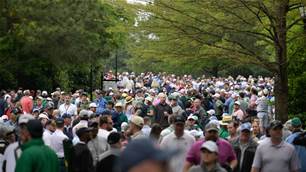The proud “father” that is Greg Norman came to watch his 13-strong LIV clan in action at the Masters Tournament.
He even paid his own way (although it would be fun to ask Norman the price of his ticket), a state of affairs that provoked an offer of free entry to next year’s tournament from arch-LIV critic, Fred Couples. Which is perhaps appropriate and in keeping with the sometimes unfeeling way Augusta National treated the Great White Shark over the course of his own playing career. The names and dates “Larry Mize 1987 and Nick Faldo 1996”, much surely resonate still beneath what once were Norman’s blonde locks. And not in a good way.
Anyway, walking outside the ropes alongside his fellow patrons, the now 69-year-old Australian icon was treated to a collective display that pretty much mirrored his own 23 appearances (three times 2nd, another three times 3rd, once 4th and 5th alongside six missed cuts) in golf’s most important tournament. There was some great play. There was a bit of so-so golf. And there was some absolute c—p.
“Leading” the way in the last of those categories was Adrian Meronk. The lanky Pole, a former Australian Open champion and a man many feel should have been part of last year’s European Ryder Cup side finished 14-over-par (78-80) for the 36-holes he played (badly). As many as 18 bogeys littered the 30-year old’s cards, relief coming only in the shape of a measly four birdies. This was a Masters forget.
Almost as bad was 2020 Masters champion, Dustin Johnson. The former World No. 1 (now ranked 336th in the wake of his absence from eligible events) and holder of the 72-hole 20-under-par record in this event (albeit with an asterisk as it was achieved in the Covid-hit November Masters) managed only one birdie in his 36-holes. The damage – ten bogeys and two doubles – was perhaps even more embarrassing for someone who used to be the man to beat. Now, at least on this evidence, he is the man almost everyone beats.

Dragging along in the “what has happened to you?” category are former Masters champions Bubba Watson and Charl Schwartzel. The latter staggered to an 11-over-par total that was only one worse than the former. Both, one fears, have seen their best days, which perhaps justified their decision to jump from the PGA Tour to LIV.
Elsewhere, mediocrity – Phil Mickelson, Joaquin Niemann four-over-par and defending champion, Jon Rahm on five-over – was the prevailing LIV norm. Although Rahm deserves some credit for making it through to the weekend. Outside what looked like the cut with four holes to play, the burly Spaniard found a couple of belated birdies from somewhere in his damaged psyche to survive. Which must have come as a relief. The dreary prospect of hanging around for two days before easing the new champion into a green jacket can’t have been appealing.

Rahm’s retreat from the brink was in stark contrast to the fate that befell Rahm’s compatriot, Sergio Garcia. One week on from losing a play-off at Doral in the most recent LIV event, the 2017 Masters champion made a double bogey six on the final hole to drop from just inside the cut-line to just outside. Still, that does at least spare the weekend spectators the glaring prospect of yet another garish LIV outfit modelled by the seemingly shameless Spaniard.
All of which only adds to the widely-held perception that participation in the LIV Golf League can be damaging to your medal (play) health. The combination of predominantly weak fields, not-great courses and a format that is both shorter than the norm and conflicted by the combination of individual and team play would seem to have had a detrimental effect on the play of most.

There were exceptions, of course. DeChambeau’s play over the first half of this Masters has been, well, masterful. The big-hitting eccentric has handled the tricky weather conditions on one of the world’s most demanding lay-outs with an endearing panache. On six-under-par and tied for the halfway lead he clearly has a chance to add a green jacket to his U.S Open title.
And then there is Cam Smith. While the mulleted-one might not be performing on quite the same level that carried him to Open Championship victory at St. Andrews in 2022, the 30-year-old Aussie is one-under-par. So far, he seems to have retained enough of his skills to compete with the best. Tough conditions are his forte too. With everyone around him struggling to hit fairways and greens, the strength of the Smith game – chipping and putting – might just carry him close to a second major victory. Should that occur, Uncle Greg (having renounced fatherhood) would surely be proud, even if disowning most of his LIV nephews must have crossed his mind over the first half of this 88th Masters.
Only two men in red figures, an average score of 74.5 and collectively 65-over par are not figures the LIV propaganda machine will be using to illustrate the quality of play on the rebel circuit.
Related Articles

Huggan: Before too long, Augusta’s mildly amusing rules gravitate to irritating

Huggan: Confident tours wouldn't be bothered by LIV Golf













